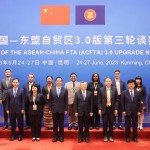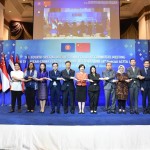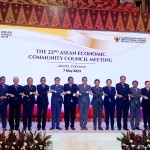Tổng số bài đăng 441.
On October 30, 2025, on the sidelines of the APEC Economic Leaders’ Meeting held in Gyeongju, Republic of Korea, Minister of Industry and Trade of Viet Nam, H.E. Nguyen Hong Dien and Minister for Sustainability and the Environment and Minister-in-Charge of Trade Relations of Singapore, H.E. Grace Fu signed the Memorandum of Cooperation on Rice Trade between the two countries.

Under this MOC, Viet Nam will facilitate rice exports to Singapore in quantities mutually agreed upon by the two sides, based on Singapore’s demand and subject to specific arrangements. This is Singapore’s first-ever MOC on rice trade, making Viet Nam the first partner in this field — a significant milestone, especially as Singapore also views several other rice markets as potential partners.
The strengthened rice trade cooperation between Viet Nam and Singapore not only benefits both sides but also serves as a concrete testament to the joint efforts in ensuring supply chain resilience and food security within ASEAN.
According to the Viet Nam Trade Office in Singapore, several factors could explain why Singapore chose Viet Nam for this cooperation: (i) First, Viet Nam’s rice has a stable supply and trusted quality. Each year, Singapore imports around 350,000–400,000 tons of rice. Viet Nam is one of Singapore’s top three rice suppliers, with a consistent output and steadily improving quality, increasingly recognized and trusted by Singaporean consumers. Therefore, signing the first MOC with Viet Nam helps Singapore ensure a sustainable and stable rice supply, price stability, and supply chain resilience. (ii) Second, the Comprehensive Strategic Partnership between Viet Nam and Singapore fosters close cooperation across sectors such as trade, investment, logistics, energy, and green technology. Viet Nam’s political stability and policy consistency have made Singapore confident in selecting Viet Nam as its first partner in the sensitive area of food security. (iii) Third, the two countries are geographically close, with well-developed port and logistics infrastructure. The efficient maritime connectivity between Viet Nam and Singapore shortens transport time and reduces costs, giving Viet Nam a clear competitive edge. (iv) Fourth, Viet Nam and Singapore have shared vision for sustainable agriculture. Both nations are pursuing green, clean, and transparent agricultural supply chains. Viet Nam is transitioning toward high-quality, low-carbon rice production, aligning with Singapore’s food security strategy. Thus, the MOC also represents a strategic step toward sustainable development and regional food security. (v) Fifth, the MOC could serve as an example for ASEAN food security cooperation. Singapore often selects high-potential partners to establish pilot models. Therefore, this MOC could serve as a starting point for Singapore’s initiative to build an ASEAN food security network, with Viet Nam as a key production and supply hub./.
Source: Compiled by the Multilateral Trade Policy Department, Ministry of Industry and Trade of Viet Nam












